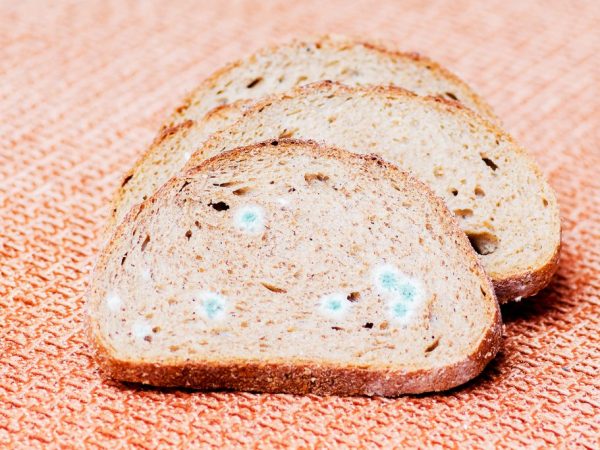Description of higher and lower mushrooms
The modern scientific classification of living nature separates all existing mushrooms into an independent kingdom and divides them into higher and lower mushrooms. Consider the main differences and what is the impact of both on the living and plant world?

Description of higher and lower mushrooms
Lower mushrooms
Lower fungi are organisms in which the vegetative body is formed by a non-cellular (non-septal) mycelium. They have it extremely branched and multinucleated, it is a highly overgrown unicellular organism. They are often called micromycetes.
The most common representatives of the lower fungi are described below.
Phytophthora
This representative can completely destroy many cultivated plants from the Solanaceae family (tomato, eggplant, potato, pepper) in a short time, causing a dangerous disease late blight. For your information. Infection of healthy plants occurs through the stomata of the leaves. As a result, dark spots form on the leaves; in wet weather, the leaves turn black and die. The mycelium is located in the mesoderm of the leaf, but the sporangiophores look out through the stomata.
Phytophthora filamentous unicellular organisms are parasites not only of cultivated plants. They show phytopathogenic properties to grasses, shrubs and trees. The phytophthora fungus lives in the soil and affects both underground and aboveground parts of plants with dry black rot.
Previously, late blight, like all lower fungi, multiplied by zoosporangia containing asexual zoospores. In a warm environment with high humidity, favorable for their germination, the development of phytophthora occurs in just 4-5 hours.
From about the middle of the last, twentieth century, scientists began to observe new populations of this fungus, which, as a result of genetic crossing and mutations, acquired the ability to reproduce sexually. The new fungal organism is much more resistant to temperature conditions, since it forms oospores capable of wintering in the soil for a long time.
Mukor
White mold can be found on moldy bread products, fruits, berries, vegetables, and other foods.
The appearance is more reminiscent of a multicellular fungal organism. In fact, mucor is only one cell, strongly overgrown, in which there are numerous nuclei in the cytoplasm.
At the beginning of its formation, the mold gives the impression of white cotton wool, but as it grows, the white color of the mold changes to black. The light fibers-strings of this cotton are sporangiophores, they hold on themselves spherical sporangia (black heads). In black sporangia, spores mature for reproduction.
The appearance of this fungal organism in the house only brings trouble, but under natural conditions, white mold performs a useful function of decomposing the remnants of various dead organic matter.
Olpidia cabbage
This single-celled fungus is called the cabbage "black leg" because of all cultivated plants it affects mainly young seedlings.
Zoospores of the parasitic fungus, entering the plant cell, become multinucleated and turn into zoosporangia. New zoospores are formed in them, and over a period of 5-10 days, the entire cycle of damage is repeated anew.
Irina Selyutina (Biologist):
The zoospore of cabbage olpidium is characterized by the presence of one posterior long and smooth flagellum. Getting on the surface of the plant root, it is dressed with a shell, while simultaneously dissolving the host's integument and pours its contents into its epidermal cell. From it, after repeated division, a zoosporangium is formed. If for some reason the germination of a zoosporangia (release of zoospores) is delayed, then zoospores from different sporangia can merge in pairs; it then behaves like a zoospore.
Plants such as clover, alfalfa, tobacco, flax, peas, etc. also suffer from infection with olpidium.
Synchitrium
This intracellular pathogenic parasite becomes the causative agent of potato cancer.
At the site of the lesion, tuberous tumor-like growths appear, which quickly increase in size and turn black. Under the influence of the pathogen, the affected potato cell grows, and the cells around it begin to actively divide, creating a rosette with the parasite body in the central cell. It forms a cyst with several zoosporangia.
When the tumor erupts, the zoospores are released and re-infect the plants. Potatoes affected by the synchritium fungus are categorically not recommended to be eaten.
All pathogenic fungi in the process of life and reproduction produce mycotoxins, contaminating crops, vegetables, fruits and food. In humans and animals, under the influence of mycotoxins, poisoning (mycotoxicosis) of varying severity up to death, infectious diseases and malignant tumors occur.
Higher mushrooms

Mushrooms can be edible or non-edible
Higher fungi are multicellular fungal organisms in which hyphae are separated by membrane septa into separate cells. They are divided according to the way of feeding into parasites, saprophytes and symbionts.
The subkingdom includes 5 departments, 2 of which are main:
- Ascomycetes, the spores of which form in bags inside special cells (asci).
- Basidiomycetes, they have spores outside in special parts of the fungus (bisidia).
For example, in the everyday sense, higher mushrooms usually mean fruiting bodies, which are divided into edible, conditionally edible, inedible and poisonous.
Also called mushrooms and gelatinous mass used to ferment liquid food. As a rule, this category includes yeast and lactic acid bacteria, as well as kefir and kombucha.
Penicillium
This representative can be found almost everywhere - in the air, soil, on plants and food. Penicillum spores are found in small brushes at the ends of the mycelium hyphae, and the mycelium is externally presented in the form of densely intertwined threads. Due to its medicinal properties, penicillum colonies are bred for medicinal purposes to produce the antibiotic penicillin.
Irina Selyutina (Biologist):
Representatives of the genus Penicillus were found almost simultaneously with Aspergils due to their generally similar ecology, wide distribution and morphological similarity. Penicillus is represented by the highest fungi saprotrophs, which occupy the first place in distribution among soil fungi. Unlike flour, they form a bluish or greenish mold. The multicellular mycelium consists of branched hyphae separated by septa. From the mycelium, fruiting filaments with formations branched in the form of brushes rise upward, on which spores form.
Under natural conditions, the penicillus mushroom performs the function of a biological orderly, and at home it contributes to the spoilage of food.
Aspergill
This fungal organism is classified as a higher aerobic mold. It differs from mucor and penicillus in that its fruiting filaments of mycelium on their tops have thickenings with rod-like outgrowths, which at first glance resemble a "disheveled head". Chains of spores are detached from these outgrowths.
The mycelium of Aspergillus has membranous septa. As a rule, reproduction occurs by zoosporangia, but some species of Aspergillus are capable of reproducing sexually.
Aspergillus is important for humans in medicine for the production of medicines, but certain species are powerful pathogens that release toxins and cause infectious diseases of various kinds.
Fruit bodies
The highest mushrooms from the point of view of an ordinary person are those that form fruiting bodies. In fact, mycologists include all mushrooms with multicellular mycelium.
The cap mushrooms we are accustomed to are the owners of fruiting bodies, characterized by their reproductive function and various mushroom-shaped forms (caps, rounded, fan-shaped, etc.).
Edible beneficial mushrooms make a significant contribution to the diet of animals and humans.
Differences between lower and higher mushrooms
There are certain signs by which some representatives are distinguished from others:
- The structure of the mycelium (mycelium): in the lower mycelium has a non-cellular structure, in the higher it is cellular.
- Life expectancy of mycelium (mycelium): in the lower mycelium there is about five days, in a number of higher ones - up to several years or more.
- Reproduction: in the lower ones, asexual reproduction can occur with the help of zoospores.
- The vegetative part: in the lower ones it is represented by pseudoplasmodium (plasmodium), in the higher ones - by hyphae (cells with a pronounced membrane septum).
- Type of nutrition: part of the lower ones are inherent in 2 types of nutrition - holozoic and absorptive, in the higher ones - only absorptive.
- Number of departments: the lower ones are represented by a number of departments, while the higher ones include only 3.
Outcome
We found out what the lower and higher mushrooms are and how they differ. Knowing the main characteristics, you can easily classify the fruiting bodies and the varieties belonging to them.


